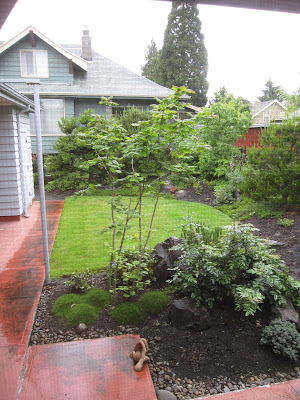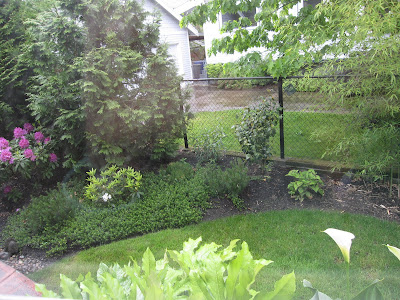The regular and unrelenting showers this month have severely depleted my limited reserves of inner sunshine. When the sun (temporarily) comes out, I'm at my desk at work, and it seems whenever I'm home, the rains return. Because Mother Nature apparently missed the memo about my half-day Fridays, here are the views from my rooms on another rainy Friday afternoon (some taken through the screens resulting in an even mistier look.)
From the north utility room window, the Northwest Territory. Unlike the MulchMaid, the vine maple and other native species in this part of the garden love this wet weather and are thriving in it.
Same room and window, angling slightly toward the northeast.
From the left breakfast room bay window. I'm cheering on the small camellia against the fence, but the cedars to the north are filling in well.The fatsia japonica has made it above the window sill this year!
George and Martha, the flamingos, are holding court in the bamboo bed seen from the middle bay of our big breakfast room window.
I thinned the bamboo earlier this year and found several runners making their way through the sand barrier when I checked it. The sand trap method, which I described here in an earlier post, seems to be working well.
From the southwest bay of the breakfast room. Now we're getting into MulchMaid territory. See those stakes on the left? Three of them have sprouts from Eucomis pole-evansii in front of them. They're late, but just you wait until, um, August?
Also barely visible behind them is the small, recently planted Callistemon viridifloris. I have high screening hopes for this shrub, since the fig starting to leaf out a little further south does nothing for our privacy in winter.
Looking southeast out of the deck doors.
Last view from the breakfast room, and it's a big one to the south through our deck doors. Everything looks so green for a Mediterranean garden. The ceanothus and cistus are enhancing the eucalyptus nicely this May as they both bloom their hearts out.
Moving into the kitchen, here's my view from the kitchen window as I stand at the sink. Even when I can't be out there, at least I can imagine sitting on the deck with a glass of wine.
All my overwintered agaves are lined up under the shelter of the soffit where they will get any sun that appears. Sun? Did I say that? They have been outdoors since mid-April and I wonder how much longer I will need to leave them under cover.
Now we're in my dining room, looking out the east window. It has a great view of the southern part of the back garden. I usually position myself in the best seat for this view when I set the table.
Two ceanothus thyrsiflorus Victoria are putting on a show on both sides of the fence, seen from the south-facing dining room window. Last month, this view was dominated by the flowers of the malus 'Prairifire' visible beyond in the parking strip.
Next to the ceanothus, in what this month is laughingly referred to as the "hot bed", my newly-planted olive, and grevilla are trying hard to see themselves commanding the space in the future.
These are the views that keep me anticipating my outdoor gardening and relaxation time all year long.
Will any of that that happen this long holiday weekend? At 9 o'clock on Friday night, it's not looking very promising.
But there's always next weekend.




































